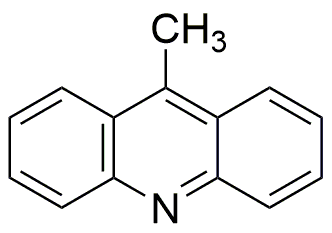9-Methylacridine is widely utilized in research focused on:
- Organic Synthesis: This compound serves as a versatile building block in the synthesis of various organic molecules, enabling chemists to create complex structures efficiently.
- Fluorescent Dyes: Its unique properties make it an excellent candidate for developing fluorescent dyes used in biological imaging and diagnostics, enhancing visibility in microscopic studies.
- Pharmaceutical Development: 9-Methylacridine is explored for its potential in drug design, particularly in developing new therapeutic agents with improved efficacy and reduced side effects.
- Electrochemical Applications: This chemical is used in the development of electrochemical sensors, offering high sensitivity and specificity for detecting various analytes in environmental monitoring.
- Material Science: It contributes to the formulation of advanced materials, including polymers and coatings, that require specific optical or electrical properties for industrial applications.
General Information
Properties
Safety and Regulations
Applications
9-Methylacridine is widely utilized in research focused on:
- Organic Synthesis: This compound serves as a versatile building block in the synthesis of various organic molecules, enabling chemists to create complex structures efficiently.
- Fluorescent Dyes: Its unique properties make it an excellent candidate for developing fluorescent dyes used in biological imaging and diagnostics, enhancing visibility in microscopic studies.
- Pharmaceutical Development: 9-Methylacridine is explored for its potential in drug design, particularly in developing new therapeutic agents with improved efficacy and reduced side effects.
- Electrochemical Applications: This chemical is used in the development of electrochemical sensors, offering high sensitivity and specificity for detecting various analytes in environmental monitoring.
- Material Science: It contributes to the formulation of advanced materials, including polymers and coatings, that require specific optical or electrical properties for industrial applications.
Documents
Safety Data Sheets (SDS)
The SDS provides comprehensive safety information on handling, storage, and disposal of the product.
Product Specification (PS)
The PS provides a comprehensive breakdown of the product’s properties, including chemical composition, physical state, purity, and storage requirements. It also details acceptable quality ranges and the product's intended applications.
Certificates of Analysis (COA)
Search for Certificates of Analysis (COA) by entering the products Lot Number. Lot and Batch Numbers can be found on a product’s label following the words ‘Lot’ or ‘Batch’.
*Catalog Number
*Lot Number
Certificates Of Origin (COO)
This COO confirms the country where the product was manufactured, and also details the materials and components used in it and whether it is derived from natural, synthetic, or other specific sources. This certificate may be required for customs, trade, and regulatory compliance.
*Catalog Number
*Lot Number
Safety Data Sheets (SDS)
The SDS provides comprehensive safety information on handling, storage, and disposal of the product.
DownloadProduct Specification (PS)
The PS provides a comprehensive breakdown of the product’s properties, including chemical composition, physical state, purity, and storage requirements. It also details acceptable quality ranges and the product's intended applications.
DownloadCertificates of Analysis (COA)
Search for Certificates of Analysis (COA) by entering the products Lot Number. Lot and Batch Numbers can be found on a product’s label following the words ‘Lot’ or ‘Batch’.
*Catalog Number
*Lot Number
Certificates Of Origin (COO)
This COO confirms the country where the product was manufactured, and also details the materials and components used in it and whether it is derived from natural, synthetic, or other specific sources. This certificate may be required for customs, trade, and regulatory compliance.


